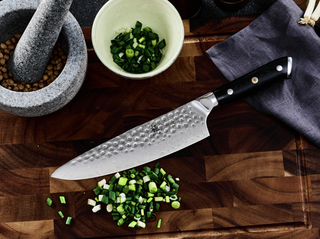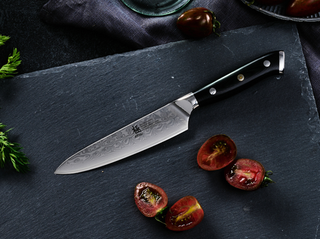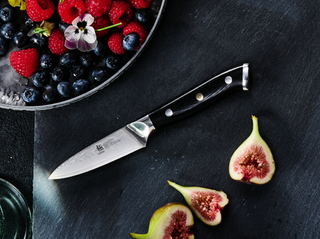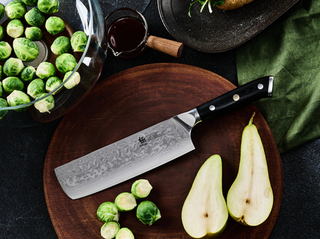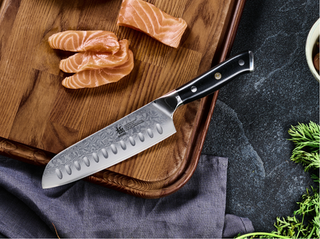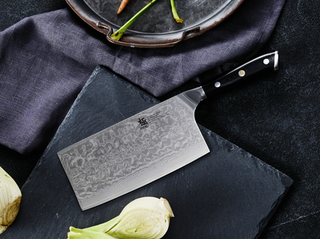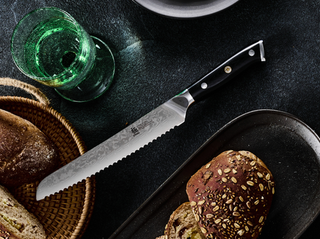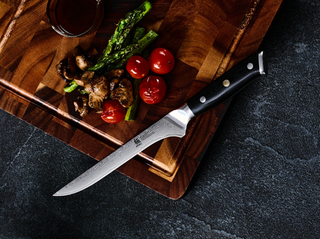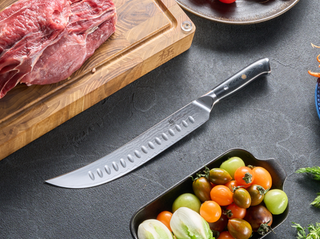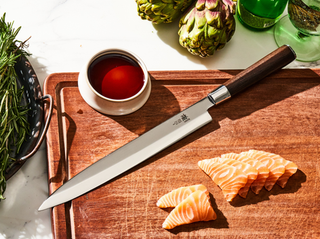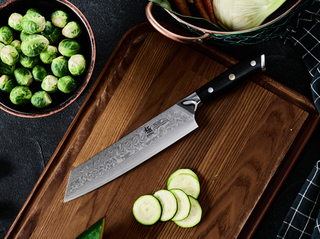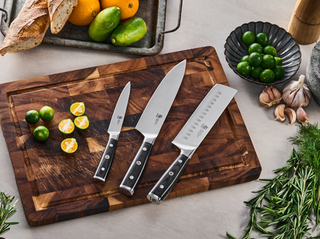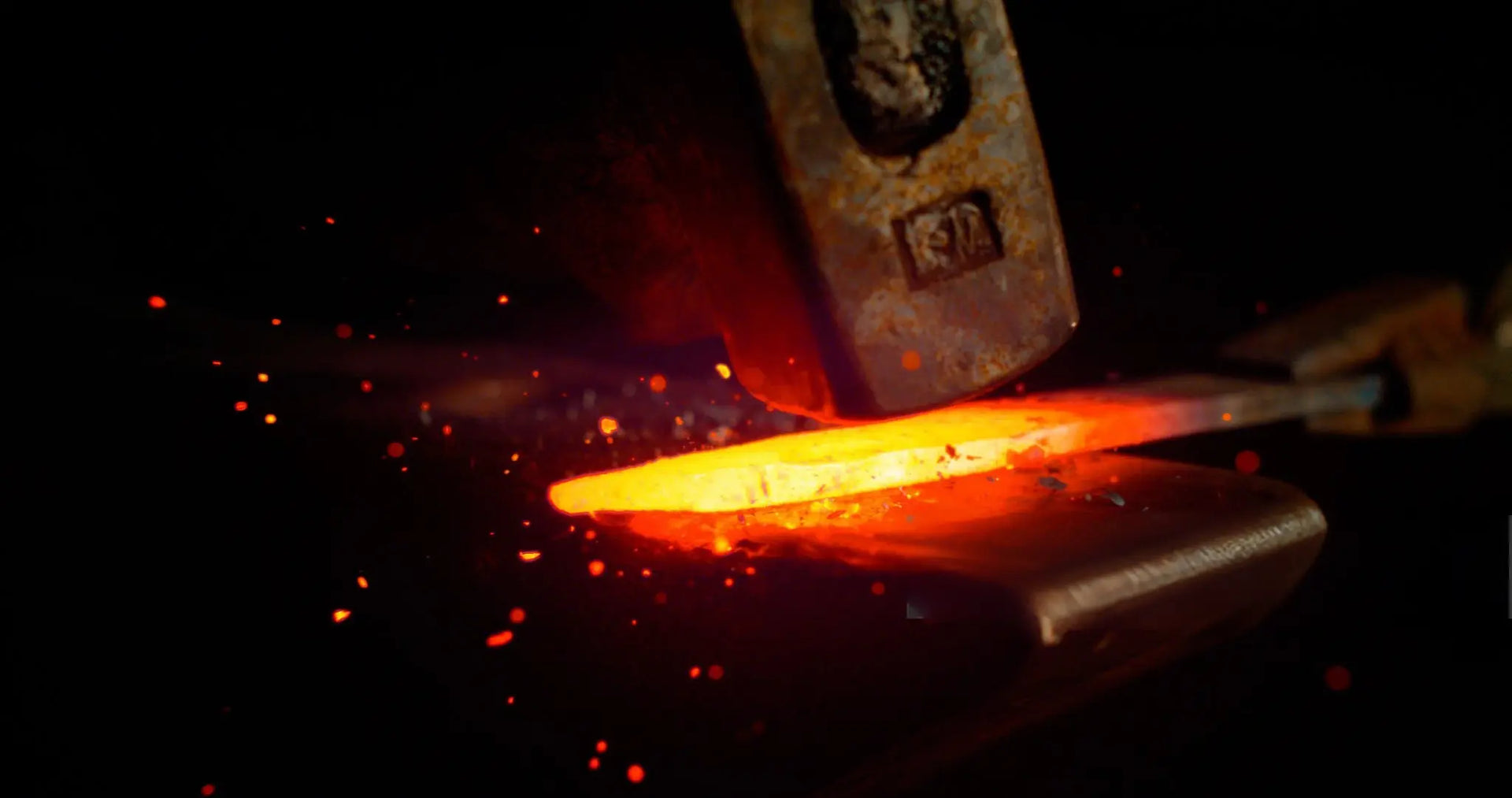The main difference between carbon steel and stainless steel comes down to one ingredient: chromium.
Carbon steel knives contain mostly iron and carbon (0.5-1.5%). This simple mix gives them special properties that many chefs love.
Stainless steel knives contain those same elements plus at least 10-15% chromium. This addition creates a protective layer that fights rust and staining – hence the name "stainless."
Here are two ideas that can be true at the same time: Carbon steel knives offer better performance. Stainless steel knives are more practical for most people.
What Makes Carbon Steel Knives Sharper: The Edge Retention

Carbon steel knives get stupidly sharp – often sharper than their stainless counterparts. They hold their edge longer and are easier to resharpen when they are dull.
The harder steel (typically 58-65 on the Rockwell scale) makes carbon knives the go-to choice for professionals. When you need precise cuts through tough vegetables or raw meat, that extra sharpness makes a real difference.
Stainless steel knives still get reasonably sharp, just not quite as sharp as carbon steel. They might need more frequent sharpening and take more effort to get back to peak performance.
For most home cooks, this difference only matters during detailed work like filleting fish or precision chopping. Day-to-day cutting tasks won't reveal much difference.
How to Test Knife Sharpness at Home
A truly sharp knife should easily slice through paper with minimal pressure. For a more advanced test, try cutting a ripe tomato – a sharp knife will slice through the skin without squishing the fruit underneath.
I've found that my carbon steel santoku can slice tomatoes paper-thin even after weeks of regular use, while my stainless chef's knife needs honing before attempting the same task.
When to Oil Your Carbon Steel Knife
Apply a thin layer of food-grade mineral oil whenever the blade appears dry or after working with acidic foods. For most home cooks, this means oiling once every 1-2 weeks with regular use.
Maintenance Make Stainless Steel Easier to Own

Carbon steel demands attention – almost absurdly so. Leave it wet in the sink for 30 minutes, and you'll find rust spots.
You must dry these knives immediately after use. They react to acidic foods like tomatoes and lemons, often discoloring right before your eyes.
They need regular oiling to prevent oxidation. This is the carbon steel monkey paw: exceptional performance with exceptional maintenance needs.
Stainless steel, meanwhile, resists rust and corrosion like a champion. It handles acidic foods without complaint and doesn't require immediate drying (though it's still good practice).
No oiling is necessary, and it maintains its original appearance for years. This low-maintenance nature makes stainless steel the universal choice for busy kitchens and beginners.
Pros And Cons of Stainless Steel Knives
Modern high-quality stainless steel knives, particularly those featuring VG10 steel (a premium Japanese stainless steel), offer excellent performance while maintaining that crucial corrosion resistance.
VG10 steel combines the best of both worlds—it's a stainless steel with enough carbon to provide superior edge retention.
While top-tier stainless steel knives can be very sharp too, they generally don't quite match the ultimate sharpness of carbon steel. The chromium that makes them stainless creates a slightly less fine edge.
How the Patina Factor Creates Beauty in Change
One unique aspect of carbon steel is how it changes with use. The blade develops a bluish-gray patina – a natural layer that forms as the metal reacts with foods.
Many knife enthusiasts love this feature. Each knife becomes uniquely yours, telling the story of your cooking journey.
That patina also helps protect the knife from further corrosion. It's like the knife is building its own character over time.
Stainless steel, meanwhile, looks pretty much the same on day 1,000 as it did on day 1. There's no story, no evolution – just consistent, unchanging performance.

What Foods Create the Most Beautiful Patinas
Proteins like meat and fish tend to create blue-purple patinas, while onions and potatoes often produce grayer tones. In my experience, slicing raw beef creates the most striking blue patina patterns – my carbon steel knife developed a gorgeous swirled pattern after breaking down just three ribeye steaks.
When to Choose Carbon Steel Knives
Carbon steel knives are ideal for serious cooking enthusiasts willing to give their tools extra TLC. Professional chefs who need the sharpest possible edge won't settle for less.
People who enjoy the process of maintaining their tools will appreciate carbon steel. Those who want tools that develop character over time will love watching the patina form.
Carbon steel knife offers the best performance for the price. But only if you're willing to put in the work.
If you're new to carbon steel knives, start with a smaller utility knife rather than a chef's knife. This lets you experience the benefits while developing good maintenance habits with less investment.
Who Should Choose Stainless Steel Knives?
Stainless steel makes more sense for busy home cooks who need practical, low-maintenance tools. Beginners who don't want to worry about special care routines will find stainless steel forgiving.
People who cook a lot of acidic foods will avoid the frustration of constant reactions. Those who prefer tools that stay looking new will appreciate stainless steel's consistent appearance.
Cooks in humid environments where rust is a bigger concern can rest easy with stainless. The era of worrying about your knives is over.
The Best of Both Worlds
Many knife enthusiasts eventually build a collection with both types. A stainless steel chef's knife for everyday tasks and acidic foods keeps things simple.
A carbon steel knife for precision cutting and special occasions lets you experience that ultimate edge. This combination gives you versatility while letting you enjoy the benefits of both materials.
The window to easy cutting doesn't have to close – you can have both.
3 Essential Questions for Choosing Your Knife
-
How much maintenance am I willing to do? Be honest about your habits. If you tend to leave dishes in the sink, stainless is probably safer.
-
What kinds of foods do I cook most often? If you work with lots of acidic ingredients, stainless will be less frustrating.
-
What matters more: ultimate performance or convenience? This is the fundamental tradeoff between the two types.
Conclusion

Neither type is objectively "better" than the other. Carbon steel and stainless steel knives represent different sets of priorities.
Carbon steel prioritizes performance and tradition, accepting higher maintenance as the cost. Stainless steel prioritizes convenience and durability, accepting slightly less cutting performance as the tradeoff.
The best knife for you is the one that fits how you actually cook – not how you wish you cooked. Be realistic about your habits and preferences, and you'll make the right choice.
Even today, when there are so many knife options available, these two classics remain the best choices for most cooks. The question isn't which is better – it's which is better for you.
Frequently Asked Questions About Carbon Steel and Stainless Steel Knives
Are carbon steel knives better than stainless steel?
Carbon steel knives offer superior sharpness and edge retention but require more maintenance. Stainless steel knives resist corrosion and are lower maintenance. Neither is objectively "better" – it depends on your priorities and cooking habits.
Do professional chefs prefer carbon or stainless steel knives?
Many professional chefs prefer carbon steel knives for their exceptional sharpness and cutting performance. However, busy restaurant kitchens often use stainless steel knives for their durability and lower maintenance requirements. Many professionals own both types.
How often do I need to sharpen each type of knife?
Carbon steel knives typically need less frequent sharpening – perhaps every 2-3 months with regular use. Stainless steel knives might need sharpening every 1-2 months. Both benefit from regular honing and sharpening.
Can carbon steel knives rust if I'm not careful?
Yes, carbon steel can develop rust spots quickly if left wet or exposed to acidic foods. This is why immediate cleaning and drying after use is essential. The patina that develops on carbon steel provides some protection, but doesn't make the knife rust-proof.
Is the patina on carbon steel knives safe for food?
Yes, the patina that develops on carbon steel knives is completely food-safe. It's simply a layer of stable oxidation that actually helps protect the knife from further corrosion. Some chefs deliberately force a patina to develop for both aesthetic and practical reasons.
What's the price difference between good carbon steel and stainless steel knives?
For comparable quality, carbon steel knives are often 15-30% less expensive than their stainless steel counterparts. A good carbon steel chef's knife might cost $80-150, while a similar quality stainless steel knife might range from $120-200.
Further Reading:
What Is Food Grade Mineral Oil
